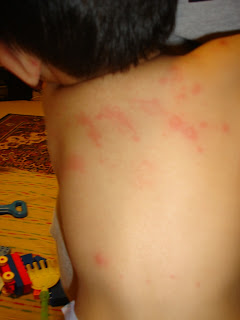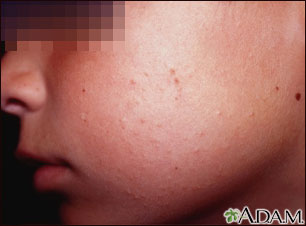Why Drug Allergies Matter (Or Why Penicillin Allergy is Responsible for My Son's Lopsided Neck)
My 6 year son old just got over a rite of passage - strep throat and scarlet fever. Unfortunately, before we could even celebrate his recovery, I noticed a swelling on the left side of his neck. It was red and tender, and it was GROWING. The pediatrician in me worried, "Damn. Lymphadenitis (infected lymph node)". No sooner had we finished one course of antibiotics than we were onto another, and the side effects were bad enough to keep him out of school for another three days.
Why did my munchkin suffer so? My answer: Drug allergy.
Group A streptococcal bacteria (the cause of strep throat and scarlet fever) is remarkably sensitive to penicillin. Penicillin is the first choice treatment for strep throat, and has been proven to reduce the risk of developing rheumatic fever, a post-infectious complication which can result in chronic heart disease.
Problem is, my son is allergic to antibiotics in the penicillin family. At 11 months of age (8 days into his second ever course of amoxicillin for an ear infection) he developed generalized hives, severe dermatographism (hives after scratching), swollen hands and feet, fever, and giant purple target-shaped lesions all over his body. High-dose antihistamines didn't help. It took a course of oral steroids to ease his misery, and even then, it took nearly 2 weeks for his symptoms to improve. The dermatographism lasted for almost a year. This type of delayed allergic response is known as serum sickness, and is mediated by immune complexes which deposit in various tissues. The photos below are from the beginning stages, before things got really bad... at the peak of his symptoms, his feet were so swollen they wouldn't fit in his shoes.
I've been practicing medicine since 2003, and the one of the most miserable case of hives I've seen was in my baby boy. For better or for worse, the memory of my son's drug reaction is the yardstick by which I subconsciously measure the severity of my patients' skin conditions.
So you can imagine why I'd fight off an army of flying monkeys before I would deliberately expose my kid to any drug likely to elicit a similar response.
Instead of being able to have his strep infection treated with penicillin, my son had to use what is known as a "second-line" antibiotic. Within a few days, his sore throat and rash improved. But then, he developed the painful and expanding swelling on the side of his neck which indicated that the bacteria had not been fully wiped out by the second choice antibiotic. There was no choice but to go through yet another round of antibiotics. This time, we were stuck with another second-line agent. One, unfortunately, notorious for severe gastrointestinal side effects.
I can't help but wonder if this little ordeal might have been prevented if my child did not have the allergic sensitivity to drugs in the penicillin family. I also can't help but wonder how many people unnecessarily receive second- or third-line antibiotics because they erroneously carry a label of drug allergy. Often, children who experience a mild infection-induced rash while taking an antibiotic (especially amoxicillin) are told to avoid all penicillins and cephalosporin antibiotics. However, they may not truly be drug-allergic. Unfortunately, many people carry this label into adulthood.
My son has a type of allergic reaction (serum sickness) which cannot be tested for, and for which the only practical treatment is avoidance. However, this is not the case for most individuals. There is accurate outpatient testing available for immediate-type penicillin allergy. In fact, the majority of people who have been told that they are penicillin allergic actually test negative and are able to tolerate amoxicillin after all. So, before you accept a label of drug allergy, consider consulting a Board-certified allergist to help you sort through these issues. It may just help you or your child avoid the expense and complications associated with suboptimal therapies.
Why did my munchkin suffer so? My answer: Drug allergy.
Group A streptococcal bacteria (the cause of strep throat and scarlet fever) is remarkably sensitive to penicillin. Penicillin is the first choice treatment for strep throat, and has been proven to reduce the risk of developing rheumatic fever, a post-infectious complication which can result in chronic heart disease.
Problem is, my son is allergic to antibiotics in the penicillin family. At 11 months of age (8 days into his second ever course of amoxicillin for an ear infection) he developed generalized hives, severe dermatographism (hives after scratching), swollen hands and feet, fever, and giant purple target-shaped lesions all over his body. High-dose antihistamines didn't help. It took a course of oral steroids to ease his misery, and even then, it took nearly 2 weeks for his symptoms to improve. The dermatographism lasted for almost a year. This type of delayed allergic response is known as serum sickness, and is mediated by immune complexes which deposit in various tissues. The photos below are from the beginning stages, before things got really bad... at the peak of his symptoms, his feet were so swollen they wouldn't fit in his shoes.
 |
| dermatographism |
 |
| target-shaped skin rash |
 |
| targetoid hives spreading over body |
I've been practicing medicine since 2003, and the one of the most miserable case of hives I've seen was in my baby boy. For better or for worse, the memory of my son's drug reaction is the yardstick by which I subconsciously measure the severity of my patients' skin conditions.
So you can imagine why I'd fight off an army of flying monkeys before I would deliberately expose my kid to any drug likely to elicit a similar response.
Instead of being able to have his strep infection treated with penicillin, my son had to use what is known as a "second-line" antibiotic. Within a few days, his sore throat and rash improved. But then, he developed the painful and expanding swelling on the side of his neck which indicated that the bacteria had not been fully wiped out by the second choice antibiotic. There was no choice but to go through yet another round of antibiotics. This time, we were stuck with another second-line agent. One, unfortunately, notorious for severe gastrointestinal side effects.
I can't help but wonder if this little ordeal might have been prevented if my child did not have the allergic sensitivity to drugs in the penicillin family. I also can't help but wonder how many people unnecessarily receive second- or third-line antibiotics because they erroneously carry a label of drug allergy. Often, children who experience a mild infection-induced rash while taking an antibiotic (especially amoxicillin) are told to avoid all penicillins and cephalosporin antibiotics. However, they may not truly be drug-allergic. Unfortunately, many people carry this label into adulthood.
My son has a type of allergic reaction (serum sickness) which cannot be tested for, and for which the only practical treatment is avoidance. However, this is not the case for most individuals. There is accurate outpatient testing available for immediate-type penicillin allergy. In fact, the majority of people who have been told that they are penicillin allergic actually test negative and are able to tolerate amoxicillin after all. So, before you accept a label of drug allergy, consider consulting a Board-certified allergist to help you sort through these issues. It may just help you or your child avoid the expense and complications associated with suboptimal therapies.


Thanks for the advice to have an allergist test a reported penicillin allergy. (I've avoided my entire life due to a childhood rash.) My son practically has frequent flyer points from his allergist, but I never considered going myself!
ReplyDeleteSo scary. My SIL is allergic to penicillin but the kids have been ok with antibiotics. On the subject of drugs - our dentist wants to put my daughter under for fillings but I am so scared of a reaction. My daughter has multiple allergies. I am thinking of declining the procedure entirely.
ReplyDeleteMy 12 month old daughter took Augmentin for 3 days to treat an ear infection but, had severe diarrhea. Then we switched to amoxicillin. This was the 3rd time my daughter would have exposure to amoxicillin & in the past showed no allergic reaction. Suddenly she suffered from head to toe hives. She was immediately put on oral prednisone. After 2 doses she appeared to be improving. Then in the muddle of the night her hives turned into those "targetoid" hives. I rushed her to the ER cause I was afraid it would cause her to go into analphalctic shock. Probably didn't spell that correctly, but you get the idea of my fears. In the ER we were told she is suffering from a "virus." I was given some crazy long diagnosis. We returned to her pediatrician. They extended the use of the oral pred. Stating it is unknown why the hives have changed & the cause. To just continue the pred because it is preventing breathing troubles as well as ulcers in the mouth. So, we are into the at day 4 & the hives are continuously changing. I've now started oatmeal baths & calamine lotion to help her get some relief. I have a dermatologist apt. on Monday to rule out "fungal" hives. I am praying it s not te case. If so, as you ay not steroids is the worse thing you could give. I'd like to share with you more. Please contact me gscazador@yahoo.com
ReplyDelete@Anonymous-- I hope your little one feels better soon! It takes around 10-14 days for the immune complexes to form in a serum sickness reaction. It generally takes at least that long for the complexes to be cleared by the liver and spleen. Don't be surprised if there are purplish-grey "stains" left on your child's skin as the hives resolve. They will fade with time. As it would be inappropriate for me to offer medical advice online, please do consult your local Board-Certified Allergist/Immunologist if you are concerned about an antibiotic allergy.
ReplyDelete